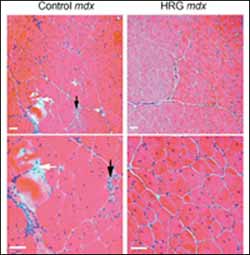Stimulating the production of utrophin protects muscular dystrophy mice from muscle wasting

Stimulating the production of utrophin with heregulin improves the quality of muscle tissue in mdx mice (right). Credit: Tejvir S. Khuranal/Proceedings of the National Academy of Sciences.
Researchers at the University of Pennsylvania School of Medicine report a novel strategy for stimulating the production of utrophin – an important muscle protein in young mice – for muscular dystrophy therapy. The investigators gave mdx mice (the mouse model for Duchenne’s muscular dystrophy) heregulin, a small molecule to turn on the production of utrophin in their muscles. Utrophin improved muscle function in the mdx mice. “Our strategy boosts the levels of an existing gene using pre-existing cellular machinery rather than having to deliver a gene via gene therapy,” says lead author Tejvir S. Khurana, MD, PhD, Assistant Professor of Physiology & Member of the Pennsylvania Muscle Institute.
They detected an approximately threefold increase of utrophin levels over control mdx mice. “This is the level at which one starts seeing a therapeutic affect, as measured in lab tests with mouse muscles,” says Khurana. The researchers noted an improvement in the quality of mouse muscle tissue, the biomechanical properties of muscles, and biochemical indices of dystrophy in the muscles.
In patients with Duchenne’s muscular dystrophy (DMD), the gene to make the protein dystrophin is missing, which results in the muscle wasting that is associated with the disease. The progressive muscle wasting begins in early childhood and typically leads to death in the twenties. “The gene for utrophin is already in the body, so by giving a small peptide to stimulate its production, we’re bypassing the need for dystrophin by cranking up the levels of utrophin,” explains Khurana. This research appears in the September 21 issue of the Proceedings of the National Academy of Sciences.
Utrophin (also called dystrophin-related protein) is found on chromosome 6 and functions much the same as dystrophin, which is found on the X chromosome. However, utrophin is made in large amounts in fetal muscles, after which dystrophin takes over throughout adult life as one of the main muscle-membrane-associated proteins. “This approach reawakens the body to make utrophin again,” says Khurana. “And it doesn’t preclude possible gene-therapy treatments for muscular dystrophy. Utrophin enrichment is a parallel strategy with great potential of being used in combination with other approaches.”
Despite these advances in an animal model of DMD, Khurana sounds a cautionary note for near-term clinical applications: “There are a number of good reasons for parents not to start thinking of giving their children heregulin at present; for one, we don’t know anything about its potential toxicity or side effects.” He stresses that this approach needs to first be properly tested in controlled trials to measure its possible long-term toxicity and efficacy in mdx mice, and then in additional animal-model studies.
Media Contact
More Information:
http://www.upenn.eduAll latest news from the category: Health and Medicine
This subject area encompasses research and studies in the field of human medicine.
Among the wide-ranging list of topics covered here are anesthesiology, anatomy, surgery, human genetics, hygiene and environmental medicine, internal medicine, neurology, pharmacology, physiology, urology and dental medicine.
Newest articles

Scientists transform blood into regenerative materials
… paving the way for personalized, blood-based, 3D-printed implants. Scientists have created a new ‘biocooperative’ material based on blood, which has shown to successfully repair bones, paving the way for…

A new experimental infection model in flies
…offers a fast and cost-effective way to test drugs. Researchers at the Germans Trias i Pujol Research Institute and Hospital have reinforced their leading role in infectious disease research by…

Material developed with novel stretching properties
KIT researchers produce metamaterial with different extension and compression properties than conventional materials. With this material, the working group headed by Professor Martin Wegener at KIT’s Institute of Applied Physics…



